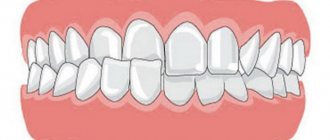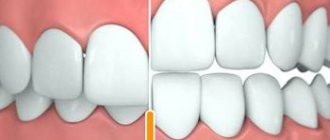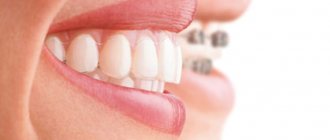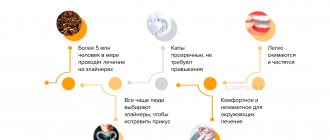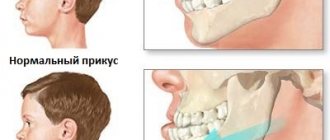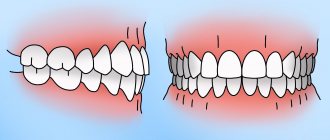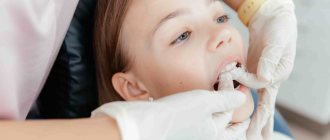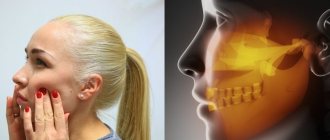- Types of malocclusion
- Causes of deformation
- Consequences of pathology
- Ways to correct deformity
Bite is the position of the teeth of the upper and lower jaws when they are completely closed. In the normal position, the upper and lower rows of teeth are located symmetrically, the incisors of the upper jaw slightly cover the lower ones. There should be no asymmetry or gaps between adjacent teeth.
How necessary is it to correct a malocclusion?
Many patients believe that there can be only one reason for visiting an orthodontist - uneven teeth. In fact, there are many more reasons to consult a specialist. The presence of dental anomalies is indicated not only by aesthetic, but also by functional problems, such as discomfort and clicking in the temporomandibular joints while chewing food and problems with diction. It is also necessary to contact dentistry to correct the bite in the presence of wedge-shaped defects, chips, increased abrasion, gum disease and noticeable facial asymmetry. An ordinary person cannot always independently detect the above problems, so the best solution would be to visit the orthodontist at least once for preventive purposes. In addition, if a patient with malocclusion requires dental prosthetics, he must undergo orthodontic treatment before installing orthopedic structures. Otherwise, the installed crown or implant for crossbite in adults and any other type of occlusion anomaly will not last long, which, in turn, can negatively affect overall health.
Dental anomalies often cause improper distribution of the load on the teeth, which leads to increased tooth wear, possible breakage of orthopedic structures, as well as wear and tear of the temporomandibular joint, the restoration of which may require surgical intervention. In addition to functional changes, dental anomalies provoke the appearance of wrinkles and other changes in appearance.
Causes of occlusion defects
There are two options why a person may have a malocclusion. The first is a congenital defect, due to any genetic failures or disorders of intrauterine development. The other is acquired after birth. Moreover, the majority of orthodontic patients “acquire” a defect in infancy, and only in a small number of people the cause is injury or illness.
We list all the causes of occlusion violation:
- genetic abnormalities;
- fetal hypotrophy during pregnancy;
- trauma during childbirth;
- breastfeeding after the baby is 1.5 years old;
- an excessively large hole in the nipple during artificial feeding;
- pacifier or thumb sucking;
- endocrine system problems: diabetes, thyroid disease;
- chronic diseases of the nose and throat;
- premature loss of baby teeth (for example, due to caries);
- increased tongue size;
- injuries to the bones of the skull and (or) jaw, especially in childhood.
Types of bite
With a correct or physiological occlusion, the teeth in a row have tight contacts, the chewing surfaces of the antagonist teeth evenly close, and the upper incisors overlap the lower ones by a third.
Types of malocclusion:
- Distal - the upper jaw protrudes significantly forward relative to the lower jaw, there may be a sagittal fissure - the gap between the upper and lower incisors,
- Mesial - the lower jaw protrudes forward relative to the upper jaw. There may be overlap of the upper incisors with the lower ones, although not always,
- Open - closure in the vertical plane is disrupted, when individual teeth or sections do not close with each other on the lower and upper jaws,
- Deep - vertical violation of closure: the position of the upper front teeth is too low - they can cover the lower ones half or entirely,
- Cross – teeth overlap each other in different sections: the upper teeth are hidden behind the lower ones or, conversely, completely overlap the lower ones in the chewing sections.
Correction of bite in adults
It is best to correct the bite while the jaw bones are in the stage of active growth, that is, up to fifteen years. It is during this period of life that most anomalies can be corrected in the shortest possible time, without resorting to surgical correction of the bite. However, even in adulthood, active and successful orthodontic treatment is possible, allowing not only to straighten the teeth, but also to achieve their correct closure, thereby ensuring the further healthy functioning of the entire dental system. Leading experts in the field of orthodontics are absolutely convinced of this.
How to correct an overbite in an adult?
Many adults who have problems with occlusion wonder how they can correct their bite and straighten their teeth. Today, modern dentistry gives several answers to this question. It all depends on the degree of complexity of the anomaly and the financial capabilities of the patient. The most popular and effective device for correcting bites is braces, both external and internal (lingual). As an alternative to correcting malocclusion with braces, modern orthodontics offers transparent aligners for correcting malocclusion, also known as aligners, one of the most aesthetic types of orthodontic equipment. The selected system, be it vestibular, lingual or mouth guards, should have the most effective effect on the anomaly. However, the results of treatment largely depend not on the design used, but on the qualifications of the doctor. Surgical intervention - orthognathic surgery - is extremely rarely required during treatment with braces.
Wisdom teeth, diastema, bruxism
According to the results of the image, the 8th teeth (wisdom) of a 16-year-old daughter grow almost perpendicular to the 7th teeth. How long can you put off the question of removing them? Is the operation difficult and painful?
— At the age of 16 you need to make a decision. Sometimes you can wait until 17, since between 16 and 18 years of age there is a residual growth of bone tissue of up to 2 millimeters in the area of the angle of the lower jaw. Therefore, the wisdom tooth can erupt normally. But at the same time, there is a risk that if there is no place in the dentition, the “wisdom” tooth will cause serious malocclusion, for example, crowding of the front teeth. The orthodontist makes a decision on removal or preservation taking into account the location, size, inclination of the tooth buds, their number and type of bite of the patient.
These teeth have to be removed in their infancy. This is a complex operation, but well mastered by our dental surgeons.
In general, the 8th teeth are rudiments that a person does not need when chewing. That's why some people are already born without eights.
Is it always necessary to correct the diastema (gap between the front incisors)? I've been living with her for 45 years. It was inherited by my son, he is 17 years old.
— If the diastema does not bother you, there is no need to do anything, because it is not a functional, but a purely aesthetic defect.
There are many reasons for the occurrence of diastema: small teeth, low-attached frenulum, etc. Depending on the cause, the question of what to do about it is decided.
How can I reduce the gap between my child’s front teeth?
- It depends on the cause of the gap. But since we are talking about a child, I want to emphasize that this issue should not be dealt with before the age of 10, because all the teeth have not yet erupted. Self-regulation may also occur, and the gap will close on its own.
Do silicone mouth guards help with bruxism? If so, is a standard one sufficient or do I need to make a custom mouth guard?
— Mouth guards are effective for bruxism. A person must decide for himself which ones to use - standard or individual, based on capabilities and preferences.
Correction of bite with braces in adult patients
As a rule, bite correction in adults is carried out using braces. A wide range of types of braces for adults allows the doctor to choose the appropriate brace system for a particular case, taking into account the wishes of the patient, ranging from traditional metal ones to invisible lingual ones. If you do not want to show off your orthodontic treatment to others, then it makes sense to choose to correct your bite with braces that are attached to the inside of your teeth. They are not visible when a person smiles or talks. However, this device for correcting the bite is more expensive than systems that are fixed on the outside of the teeth.
Consequences of lack of treatment
Many people do not think about what the consequences of not treating malocclusion can lead to, mistakenly believing that this is reflected only in appearance. In fact, the problem is much more serious than it seems at first glance.
What will happen if occlusion defects are not corrected:
- teeth will begin to wear out and decay;
- their roots will be exposed (recession);
- excessive sensitivity of the enamel will appear;
- gums will become inflamed, bad breath will appear;
- constant biting of the inner surface of the cheek can initiate the development of oncology;
- problems with the temporomandibular joint will lead to frequent headaches, difficulty chewing, and diseases of the digestive tract;
- an unattractive appearance will cause the appearance of psychological complexes.
Time frame for bite correction
How to quickly correct an overbite in an adult? This question is perhaps the most concerning for those who are thinking about orthodontic treatment. The timing of bite correction practically does not depend on the type of device; the duration of therapy is primarily influenced by the complexity of the clinical case. For example, if you have slight crowding of teeth, then in six months you can achieve quite good results. More complex anomalies will require an average of one to two years. Two and a half years is the maximum period for correcting bites in adults.
Ways to correct deformity
To correct the bite in adults, various orthodontic appliances and devices are used. This treatment promotes the displacement of individual teeth, restores the correct position of the upper and lower jaw and dentition.
Braces
If the question is how to correct a person’s malocclusion, you should pay attention to a correction method such as braces. They look like plates connected to each other by an arc. Fixation to the teeth occurs from the outside or inside.
Braces or staples act on the dentition mechanically - they slowly move the roots and stretch the tissue around them. As a result, the position of individual teeth and the entire row changes, which is effective for complex anomalies.
There are the following types of bracket systems:
- According to the method of attaching the arch to the bracket: ligature - involves connection using rubber bands and non-ligature - connected using locks or latches.
- According to the place of fixation: vestibular - attached to the outer surface of the teeth and lingual - attached to the inner surface of the teeth.
- According to the material from which they are made: metal - the most reliable, but look unaesthetic; sapphire and ceramic - the most expensive, reliable and aesthetic; plastic - the most impractical, they break quickly.
Once the correction with braces is completed, the treatment is not completed. Next comes the retention period, when the patient needs to wear a retainer or a removable mouth guard constantly, and sometimes throughout his life. This is a thin metal permanent thread that is fixed to the teeth from the inside on the tongue side.
Mouthguards
Dental aligners or aligners are a removable structure made of transparent silicone, polyurethane, and thermoplastic. To correct deformities of the jaws and teeth, mouth guards must be worn constantly and removed only when eating.
The design is made individually according to the size of the patient’s jaw. The trays are replaced at each stage of therapy, approximately every 2 to 3 weeks.
Advantages of aligners:
- almost invisible to others;
- do not cause discomfort when wearing;
- do not damage the enamel.
The disadvantage is that it is impossible to correct serious bite pathologies using mouth guards.
Trainers
Trainers are transparent, removable structures made of biosilicone. Outwardly they resemble dental guards, but are more massive. At the beginning of treatment, soft structures are selected and gradually replaced with hard ones. They have a standard shape or can be made individually.
They are most effective in children, but are also used in adults, if it is necessary to normalize the position of individual teeth, and in case of slight deformation of the jaws. Allows you to eliminate impaired breathing and swallowing functions, restore clarity of speech, and stimulate the proper functioning of the facial muscles.
The advantage of trainers is that they only need to be put on before bed and left on all night. During the day you can wear it for only 2 – 4 hours.
Orthodontic plates
What to do if the malocclusion is not very pronounced? In this case, your doctor may recommend an orthodontic plate. This design is installed on the palate and gums, fixed to the teeth using special hooks.
The plate does not cause discomfort, but is more effective in correcting deformities in childhood. In adults, it is often used at the preparation stage before installing braces.
Myogymnastics
Myogymnastics is not an independent method of correcting dental defects, but an additional one. It is impossible to completely correct the bite of an adult with its help, but it is quite possible to correct the curvature of the teeth. The effectiveness of exercises is highest when wearing orthodontic corrective structures.
Performing myogymnastics strengthens the facial muscles well. Exercises should be performed every day during the entire treatment period.
Surgical correction
Many patients, knowing the dangers of malocclusion, decide to undergo surgery. Surgical intervention is indicated for severe jaw deformation and pronounced defects. It is carried out in the following cases:
- injuries to the jaws and face;
- crossbite, causing pronounced facial asymmetry;
- open bite, causing impaired chewing function and serious speech defects;
- chin dysplasia.
The operation is performed under anesthesia. This is the fastest and most effective way to get rid of deformation, which is noticeable in the photo before and after treatment. The downside is the long rehabilitation period, up to a month or more. For several weeks, you must strictly follow the doctor’s recommendations and eat only liquid food through a tube, as special splints will be placed on your jaws.
The choice of an orthodontic device for bite correction is made by the doctor, based on individual characteristics - the type and severity of the deformation, its consequences. The patient must follow the requirements of the chosen method throughout the entire treatment period; this is the only way to obtain the desired effect.
What are the prices for bite correction in Moscow?
How much does it cost to correct a bite? In most cases, prices for correcting malocclusion in adults in Moscow depend on the complexity and nature of the anomaly. The more complex the case, the more expensive the treatment will be. So, on average, the cost of treatment with the most modern self-ligating metal brace systems will be about 150,000 rubles, and the price of ceramic braces, again self-ligating, will be approximately 170,000 rubles. The most expensive, but at the same time the most comfortable, will be correcting the bite with lingual braces, which costs from 450,000 rubles. There is also a treatment option using a combined braces system, when lingual braces are placed on the upper row of teeth and ceramic braces on the lower row. The cost of correcting the bite in this case will be about 200,000 rubles. As for treatment with aligners, its price varies from 50,000 to 280,000 rubles, depending on the number of trays used.
The listed amounts include diagnostics, installation and removal of braces, consumables, all examinations and corrections, including unscheduled ones, as well as retainers or mouthguards necessary to consolidate the results.
Diagnosis of occlusion defects
Methods for diagnosing malocclusions:
- • taking anamnesis; • visual examination, including the use of dental instruments; • examination of the condition of the facial muscles using palpation and phonetic tests (pronouncing words and letters); • radiographic examination in frontal and lateral projection (teleradiogram) – to detect skeletal anomalies; • computed tomography – to determine the condition of bone tissue and the location of tooth roots.
Our orthodontic centers are equipped with all the necessary equipment to make an accurate diagnosis. Treatment begins only after preliminary diagnosis and development of a detailed treatment plan.

